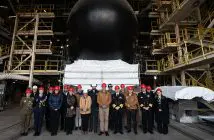
By Chris Flaherty
INTRODUCTION
This Space Terrorism Future Trends Analysis looks at Space Terrorism incidents that have occurred since 1972, as the basis of a future trends prediction. This paper will start with a fictional account of a kinetic attack on the Earth’s Satellite Layer in Low Earth Orbit, that has been identified as the most extreme terrorist act that current literature on Space Terrorism can predict. The mock-scenario is used to illustrate the likely scale, and potential limitations of such an attack taking place, and is suggested as a potential Space Security wargaming scenario.
A KINETIC ATTACK SCENARIO
The following scenario envisages a well-funded extremist collective called ‘God’s Justice for Earth’s Poor’. Envisaged as a mix of various known extremist-conspiratorial groups and militias that currently exist, this could be an interfaith-based ideology strongly oriented towards conspiratorial and extreme beliefs broadly characterised as anti-capitalist-elites, anti-world government and anti-technology. They are multi-national, funded by donations from a variety of wealthy conspiratorial believers in the West. The group have found safe-harbour in an equatorial located collapsed state, in an environmentally devastated desert region, where they have occupied an re-engineered a former insurgency tunnel system. The tunnels have been turned into a rocket building factory. The group has designed a rudimentary small-lift launch vehicle (based on various designs for a) three-stage 25 meters tall rocket, with a first stage diameter of two meters, tapering at its upper stage to 1.5 meters, with a payload of under 250 kilograms. It is able to carry its payload up to around 300 kilometres in Low Earth Orbit. The rockets are simple stainless steel fabrication, using old rocket engine components, and 3D-printed copies of well-known designs from some of the World’s most successful Space Launch Companies. The fuel type is also easy to collect and store, such as a kerosene liquid oxygen mix. Some of the technician-workers are former Space Industry employees, and recent converts. The plan is to launch several rockets from tunnels, where the group have excavated-out launch pits, or use converted flatbed trucks carrying launch rigs. Not all the rockets are expected to work, however the more that can be launched in a salvo the greater the odds, for a successful set of detonations in Space. The rockets are rudimentary and closely related to the old Soviet SCUD-like ballistic missiles. The programmed rockets are designed to fly into Low Earth Orbit, and detonate simple explosive warheads that are packed with large tungsten balls. The group’s plan is to introduce several debris clouds into Low Earth Orbit, with the potential to destroy satellites. However, their real aim is leveraging popular culture fears creating global financial and political panic. The group also intend to pirate several communications satellites where they will broadcast as long as possible globally their beliefs and claims. Claiming that the attack on the Earth’s satellites is punishment for global capitals’ system of control, and the preserve of Space for the wealthy, at the expense of the World’s poor.
This scenario is guided by the immense technological complexity for creating an actual guided ASAT – seen as the high-mark of Space Weaponization threats, and which has been largely rejected as a plausible Space Terrorist scenario (Coleman, 2017; Bernat, 2019). As an alternative, a relatively crude and low-tech solution has been substituted using a SCUD-like ballistic missile, seeking to create a set of bursts in Space presenting an indiscriminate threat to the Earth’s Satellite Layer (Miller, 2019). This is based on the following scenario:
“Attacks on satellites with SCUD-like ballistic missiles that do not have homing capabilities would have low probability of success, and would be limited to only the lowest altitude satellites. Such an attack with a conventional warhead containing shrapnel would need to place the debris cloud in the direct path of the satellite. This would require fairly precise tracking – a capability available only to highly sophisticated militaries.” (Federation of American Scientists)
However, it should be noted that a low-tech scenario for satellite tracking was demonstrated in the 1950s, in the United States, that:
“proved that this required only a minimal technology approach: amateur satellite observers used stopwatches, sky maps, personal computers and sometimes binoculars to determine satellites’ orbital elements. Hence, tracking can be done using common and inexpensive electronics with minimal training. This is in line with U.S. Undersecretary of State Robert Joseph’s concern about non-governmental satellite observers tracking satellites and posting their orbits on the internet, which can possibly … [be]… used by terrorist organizations.” (Remuss, 2009)
Another scenario has been provision from a rogue government, or conversion of an existing craft:
“In addition to a State producing and furnishing a terrorist group with an Anti-Satellite Weapon … the development of a delivery system by a terrorist group on its own through conversion of either an anti-ship cruise missile or a small airplane or by building a cruise missile themselves is also feasible.” (Remuss, 2009)
The scenario envisaged in this paper, has its fictional terrorist group largely replicating typical small-lift launch vehicles and launch pads. Not unlike that being currently developed by a number of Space Launch Companies.
SPACE TERRORISM
Since 1972, there have been several terrorism, and piracy incidents that can be linked to the Space Industry, and these are set-out in Table 1: Space Terrorism and Piracy Incidents List (1972 – 2018). While some of these incidents are historically known events, others in particular the hacking events are disputed. Britain’s Ministry of Defence denies its military communications satellites were hacked in a 2002 incident (CNET, 2002).
Broadly, the following trends can be identified: (1) Murder and kidnap threats (1972); (2) Space Agency bombing (1984); (3) Multiple hacking incidents (1999-2018); (4) Launch pad attack (2003); and, (5) Letter-correspondence threatening terror attacks at a Space research organization facility (2013). The trend pattern so far tracks with the historical transition of terrorism and extremist violence that has progressed from murder, kidnaping, and bombings; to more recent widespread use of cyber-attacks, hacking and pirating communications.
Acts of possible sabotage have been claimed in Space Terrorism literature, in relation to the 2015 twenty-year-old U.S. Air Force Defence Meteorological Satellite Program Flight 13(DMSP-F13) craft explosion. The event was attributed officially by United States authorities to a power failure, and minimized the events significance (Bernat, 2019). It has been claimed that the public delay in admitting the incident was an attempt to hide an,
“actual act of sabotage … Of course, for obvious reasons, it is difficult to determine what truly happened.” (Bernat, 2019)
A scenario commonly identified in the Space Terrorism literature, is where an entity or group acting illicitly, get a commercial launch provider to put a satellite into orbit, for what would otherwise be a legitimate Space Industry activity. This situation was claimed in the case of,
“the launch of four rogue satellites on Indian PSLV launch vehicle on 12 January 2018.” (Bernat, 2019)
The satellites belonged to Swarm Technologies – a Space start-up based in California. The company had originally been denied placing them in orbit, the:
“denial of the experimental license was based on concerns the satellites were too small to be effectively tracked by the U.S. Military’s Space Surveillance Network (SSN), which provides safety of flight information to other operators. Subsequent to the unlicensed launch, the FCC revoked another Swarm license for a planned upcoming launch on Rocket Lab’s Electron in April 2018. As of March 23, 2018, neither Swarm nor any of its known investors have commented on the situation.” (Christensen, 2018)
A basic question licence denial instances raise is that of forum shopping. This is where an entity or group are able to find a launch provider in another country, or through third-parties, and get access to a launch with little in the way of international scrutiny. It has been noted that:
“If it was possible for an American company to place in the orbit unlicensed satellites, it seems, that any other agent, including weak actors adversaries … could do the same.” (Bernat, 2019)
TABLE 1: SPACE TERRORISM AND PIRACY INCIDENTS LIST (1972 – 2018)
| 1 | 1972 | The Black September Palestinian Group threatened an attack against the Apollo 17 mission, specifically to murder or kidnap the crew or their families. |
| 2 | 1984 (3 August) | Two days before the launch of an Ariane satellite, the French left-wing group Action Directe bombed the European Space Agency’s Paris headquarters, injuring six people. |
| 3 | 1999 2002: The same/similar incident is reported. | Hackers seized control of a British military communications satellite with a home computer. |
| The same/similar incident was also reported having effected one of the satellites in Britain’s Skynet system, which delivers communications services to the Royal Air Force and other armed forces units, seized by hackers over a weekend. The British government was then the victim of an alleged blackmail threat following the attack. | ||
| 4 | 2002 (June) | China’s Falun Gong Spiritual Movement overrode the broadcast signals of nine China Central Television stations and 10 provincial stations and replaced the programming with their content |
| 5 | 2003 | NASA increased security for the Columbia shuttle launch, out of concern that al-Qaeda would attack the launch pad because of an Israeli astronaut on the flight. |
| 6 | 2004 | China’s Falun Gong Spiritual Movement disrupted AsiaSat signals for four hours. |
| 7 | 2006 | Mobile satellite communication signal provided by Thuraya Satellite Telecommunications was jammed from three widely-separated locations inside Libya. |
| 8 | 2005–2007 (April) | Sri Lanka’s Tamil Tigers: Liberation Tigers of Tamil Eelam (LTTE) hacked-hijacked the Intelsat Ltd. Intelsat-12 satellite in geosynchronous orbit, and used a vacant Ku-band transponder to broadcast-beam their propaganda into Sri Lanka and across the Indian subcontinent without Intelsat‘s knowledge for over a year. Intelsat continuously tried to interrupt LTTE’s pirating. However, the LTTE was able to continue its satellite piracy for two years. Intelsat decided to shut down the satellite transponder in late April, 2007. |
| 9 | 2010 (October) 2011 (September) | NASA computers experienced more than 5,400 incidents of malicious software or unauthorized access, in some cases described as having full control over those networks. |
| 10 | 2013 | A letter threatening terror attacks was found at an Indian Space Research Organisation facility in Bangalore, India. |
| 11 | 2015 | The European Space Agency was hacked by the group Anonymous, resulting in the leak of thousands of credentials. |
| 12 | 2015 | An Indian Space Research Organisation computer was infected with malware, which could have given hackers control of rocket launches and satellite separation. |
| 13 | 2018 (Admitted). Events prior to 2011. | Insurgency used jamming during Operation Iraqi Freedom (2003-2011). Deliberately jammed commercial satellite communications links used by the U.S. military. |
Sources: Various
Terrorists and extremist use of Space, in the Space Terrorism literature has also been raised in relation to the problem of Shutter-Control. The problem is with the proliferation of quality real-time intelligence from remote sensing satellites operated by commercial entities, for which there is little regulation nationally, or internationally (Townsend, 2021). It could be argued, terrorists and extremist could source Commercial Satellite Imagery informing their targeting, planning and post-attack assessment processes. This scenario was identified in the early 2000s:
“A terrorist organization could also use commercial images to learn exactly where the troops of a target state are and how their facilities (embassies, military bases, etc.) are laid out. A terrorist attack on the model of the attack of the American vessel USS Cole in the port of Aden in October 2000 could be organized using Space imagery.” (Nardon, 2002)
CONSPIRACY AND SPACE TERRORISM
At one end of the spectrum, there are acts of violence made against the Space Industry, seeking to attack its launches, and launch facilities. This includes the Space Agencies as another government target. The early actual terrorist threats were part of the wider Israeli conflict, or an extension of violent radical agendas pursued in France – European Union, or India (See TABLE 1). While, at the other end of the spectrum there is a terrorist or extremist aim at disrupting, or stopping activities in Space per se. Which has led to one of the few actual definitions to emerge in the Space Terrorism literature; and it relates to,
“an act of violence by one or more individuals or groups to prevent the development of a Space settlement(s) and/or their aims including those of a Spaceship or Space Station during Man‘s exploration of Space” (Cain, 2016; Bernat, 2019).
However, other Space Terrorism literature authors, have sort to widen the definition of:
“Space Terrorism as a purposeful and well thought-out act of destruction against Human and/or material resources of Space Industry undertaken by individuals or groups out of ideological motivation, where Space Industry is understood as an economic sector dedicated to producing components that go into Earth’s orbit or beyond, delivering them to those regions, and related services.” (Bernat, 2019)
Problematically, these definitions are largely underpinned by the ‘rational actor’. Current Space Terrorism literature tends to identify terrorist and extremist actions as largely driven by ‘rational ends’ (Miller, 2019). While the out-come aspects of the definitions are not in dispute, it can be argued that there is also a significant irrational aspect which needs to be considered – the role of conspiracy thinking as a motivation for Space Terrorism.
From around 2016, one of the most common conspiracy theories found in tabloid reporting, YouTube, Twitter, and various other forum involved the failure of a NASA-SpaceX mission:
“Several conspiracy theorists have taken to Twitter today to explain their bizarre theories. One user tweeted: ‘NASA don’t exist. Gov did it fake every time. They were having issues with green screen this time and hence they postponed the launch.’ Another wrote: ‘I watched the live feed for 5 hours and they didn’t launch … Clearly they were trying to find a way to fake it just like they did the Moon landing! Be better NASA.’” (Best, 2020)
Older beliefs involving the launch failure of a rocket, had led commenters on a Space news and blogging site, claiming the explosion was the result of snipers or drones with lasers (Shear, 2016). Others claimed that, ‘it was a secret attack by aliens, which they claim can be seen in the footage from the failed launch.’ (Liberatore, 2016) Interestingly, in the conversation-comments section, in regards to an aerial phenomenon seen around a 2020 launch, one individual claimed:
“It will be a type of drone scanning the rocket for nuclear weapons, if the scan proved positive the rocket plus nuclear load would have been neutralised.” (Jackson, 2020)
This belief in rocket launches are being used to send weapons into Space, is not far from the QAnon belief contained in the infamous 2018 anti-Semitic conspiracy theory claiming ‘powerful Space lasers were used to start the California Camp wildfires’. Suggesting in this case powerful business interests were financing these Space-Based weapons (Dutton, 2021).
More recent trends in Space Industry conspiracy can be found in the case of the well-published issues that SpaceX has been having with the U.S. Federal Aviation Administration (FAA) over the problem-launches experienced by the Starship prototypes (SN8 and SN9). As the saga was being reported, almost immediately on various Social Media Channels there was a proliferation of theories espoused by people in the comment section, that the ‘FAA was being paid-off to slow the progress of SpaceX’ (YouTube Video, 2021). Some adherents claimed involvement from rival Space Industry players further elaborating the conspiracy beliefs. Comments claiming these beliefs, also began to move rapidly from claimant to out-right advocacy.
The shift from claimant to advocacy on the part of a favourite company, or celebrity boss, is significant as it also starts the process where ‘enemies’ are being identified, in this case: the FAA, U.S. Government, and powerful rival economic interests – all seeking to stop the progress of the anticipated colonisation of Mars. Enemy identification (and its advocacy), could also be seen emerging in the comments on a YouTube livestream channel. A somewhat exasperated commentator alluded to people in the online comments-discussion posts making references to the ‘Lizard people’ as somehow linked to the launching problems (YouTube Video, 2021). The distinctly QAnon meme of ‘Lizard people’ being espoused, illustrates the interpretive shift that can occur where individuals use the opportunity to articulate their individual beliefs, and create conspiratorial slurs against perceived ‘enemies’ in this case the FAA. Problematically, these comments – just talk – also start to shift towards a set of constructs increasingly being seen as the actual basis for potential future terrorism.
CONCLUSION
The common mistake in building a Space Terrorism threat analysis, is to focus on outlandish beliefs – dismissing these as: ‘is this what people actually believe (or say these things)’. Instead, viewed in terms of Attractor Analysis, the question becomes: what is the focus of a belief? In the examples given, the long-standing belief is an antagonism aimed at NASA, claiming it to be behind the ‘Moon Landing Hoax’. This connects to a much more corrosive political belief in the untrustworthiness of government. In the past, the themes of alien attacks, abductions, UFO coverups, and a secret government, have all largely fallen outside the actual realm of Space Terrorism. The actual attackers have been history’s conventional terrorists, such as: the Black September Palestinian Group; or, the French left-wing group Action Directe, who identified as Libertarian Communists, who formed an urban guerrilla organization, committing assassinations and violent attacks in France between 1979 and 1987. Whereas, China’s Falun Gong Spiritual Movement, and Sri Lanka’s Tamil Tigers: Liberation Tigers of Tamil Eelam (LTTE), largely sort to utilize the existing national satellites in their own countries as a means to communicate their message. In other cases, terrorist groups have used satellite telecommunications in conjunction with the Hawala: an ancient system of fund transfers based on trust (Feldman, 2006). Rogue attacks from Libya, or hackers, largely fall into attempts at denial of service attacks and have a largely profit motive, seeking to extort money. Whereas Insurgency actions use denial of service attacks to frustrate rival militaries.
A terrorist and extremist focus on the Space Industry as a cause celebre has only recently materialized. Conspiracy advocates have been traditionally marginal elements, that in terms of actual real-world terrorism, and extremism resulting in violent attacks have been non-existent. The dramatic rise in violent conspiracy attacks since the start of the pandemic, over 2020, and 2021, has been aimed at technology such as the 5G networks, and have been anti-government, and anti-security/policing attacks. There is a considerable belief system – that is historically rooted in popular culture, seeing the Space Industry as the mega-hub of all conspiracies. This paper began with an imagined terrorist collective attempting to build and launch SCUD-like ballistic missiles into Space in an attempt to interfere with the Earth’s Satellite Layer. This fictional account has been proposed as a means to question one of the current assumptions made by the Space Terrorism literature that ultimately terrorists and extremists will have the same capabilities as any other Space Force, acquiring ASAT technology as a means to launch a direct attack on a satellite. That scenario could only be accomplished with the aid of a rogue state, as a type of third-party deniable strategy to inflict a military loss on the United States, or any other of the Space fairing countries. It is contended that this is not the only scenario, as a low-tech strike may in fact be a more likely event, conducted by a group who fall well outside the conventional terrorist model, and who are not motivated by real-world political aims; but are simply intent on ‘burning the current order down’.
AUTHOR
Chris Flaherty is a Space & Defense Tech and Security News Regular Contributor.
REFERENCES
- Bernat, P. Posłuszna, E. 2019 The Threat of Space Terrorism in the Context of Irregular Warfare Strategies. Leyla Aydemir, L. (Editor) Evaluation of Social Changes and Historical Events Based on Health, Economy and Communication in a Globalizing World. Bursa, Turcj.
- Best, S. 2020 NASA SpaceX Launch was Cancelled ‘Because it Was Fake’, Conspiracy Theorists Claim. Mirror (28 May).
- Cain, J.R. 2016 Space Terrorism – A New Environment; New Causes. Cockell, C.S. (Editor) Dissent, Revolution and Liberty Beyond Earth. Springer. Switzerland.
- Choi, C.Q. 2007 Libya Pinpointed as Source of Months-Long Satellite Jamming in 2006. Space.com (9 April).
- Christensen, I. (2018). Unlicensed Swarms in Space. The Space Review (2 April).
- 2002 Satellite Hack Raises Security Questions. CNET.com (2 January).
- Coleman, N. Coleman, S. 2017 Terrorism in Space. Examining the Issues and Mitigating the Risks. 68th International Astronautical Congress (International Astronautical Federation). Adelaide, Australia, 25-29 September.
- Dutton, J. 2021 Marjorie Taylor Greene’s ‘Jewish Space Lasers’ Conspiracy Theory Met With Derision, Jokes. News Week (29 January).
- Federation of American Scientists. United States Space Systems: Vulnerabilities and Threats.
- Feldman, R. 2006 Fund Transfers – African Terrorists Blend Old and New: Hawala and Satellite Telecommunications. Small Wars & Insurgencies. Volume 17. Number 3.
- Jackson, S. 2020 Mystery Orb Spotted Over SpaceX Rocket Launch Sparks Conspiracy Theory Frenzy. Daily News, Video News Reporter (18 December).
- Liberatore, S. 2016 Conspiracy Theorists Claim Aliens Sabotaged SpaceX Launch as Bizarre Theory Says ‘Anomaly’ Flew Over Rocket as it Went up in Flames. Daily Mail (3 September).
- Miller, G.D. 2019 Space Pirates, Geosynchronous Guerrillas, and Non-Terrestrial Terrorists. Air & Space Power Journal (Fall).
- Nardon, L. 2002 Satellite Imagery Control: An American Dilemma. The Centre Francais sur les Etats-Unis (CFE) (March).
- Remuss, N-L. 2009 The Need to Counter Space Terrorism – A European Perspective. ESPI Perspectives. Number 17 (January).
- Shear, E. 2016 Conspiracy Theories Regarding AMOS-6 FALCON-9 Explosion Not Based on Physics, Reality. Space Flight Insider (4 October).
- Townsend, B. 2021 The Remote Sensing Revolution Threat. Strategic Studies Quarterly (Fall).
- YouTube Video. 2021. For Privacy Reasons Publication Details Not Included.





